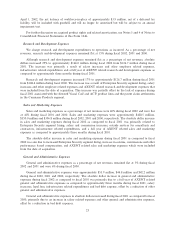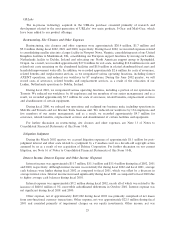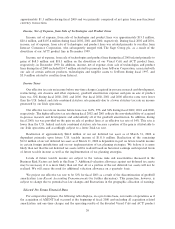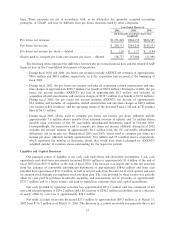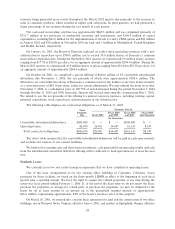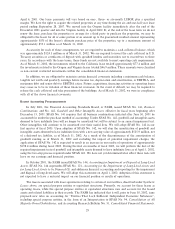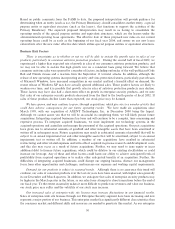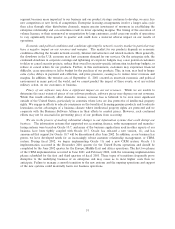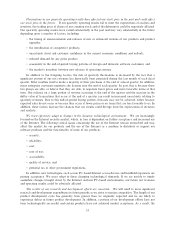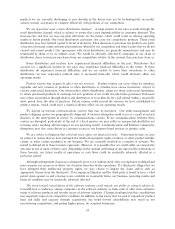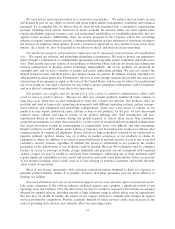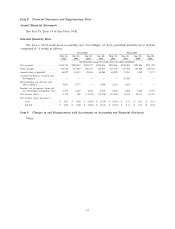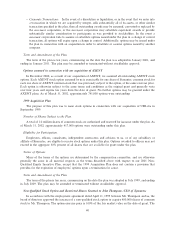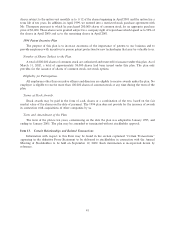Symantec 2002 Annual Report Download - page 54
Download and view the complete annual report
Please find page 54 of the 2002 Symantec annual report below. You can navigate through the pages in the report by either clicking on the pages listed below, or by using the keyword search tool below to find specific information within the annual report.Our markets are competitive and our operating results and Ñnancial condition could be adversely aÅected
if we are unable to anticipate or react to this competition. Our markets are competitive. If we are unable to
anticipate or react to this competition, our operating results could be adversely aÅected by reducing our sales
or the prices we can charge for our products. In the recent past, many of our competitors have signiÑcantly
lowered the price of their products and we may have to do the same to remain competitive. Our ability to
remain competitive depends, in part, on our ability to enhance our products or develop new products that are
compatible with new hardware and operating systems. We have no control over, and limited insight into,
development eÅorts by third parties with respect to new hardware and operating systems and we may not
respond eÅectively or timely to such changes in the market. In addition, we have limited resources and we
must make strategic decisions as to the best allocation of our resources to position ourselves for changes in our
markets. We may from time to time allocate resources to projects or markets that do not develop as rapidly or
fully as we expect. We may fail to allocate resources to third party products, to markets or to business models
that are more successful than we anticipate.
Our software products and web site may be subject to intentional disruption. Although we believe we
have suÇcient controls in place to prevent intentional disruptions, such as software viruses speciÑcally
designed to impede the performance of our products, we expect to be an ongoing target of such disruptions.
Similarly, experienced computer programmers, or hackers, may attempt to penetrate our network security or
the security of our web site and misappropriate proprietary information or cause interruptions of our services.
Our activities could be substantially disrupted and our reputation, and future sales, harmed if these eÅorts are
successful.
We face risks associated with our foreign operations. A signiÑcant portion of our net revenues,
manufacturing costs and operating expenses result from transactions outside of the United States, often in
foreign currencies. As a result, our future operating results could be negatively aÅected by Öuctuations in
currency exchange rates and general uncertainty with each country's political and economic structure. In
addition, governmental regulation of imports or exports or our failure to obtain any required export approval of
our technologies, particularly our encryption technologies, could impede our international sales. In light of
recent terrorist activity, governments could enact additional regulation or restrictions on the use, import or
export of encryption technologies. Additional regulation of encryption technology could delay or prevent the
acceptance and use of encryption products and public networks for secure communications. This might
decrease demand for our products and services.
Introduction of new operating systems may adversely aÅect our Ñnancial results and stock price. The
inclusion of security, remote access or virus protection tools in new operating systems and hardware packages
could adversely aÅect our sales. For example, the inclusion of features by Microsoft in future editions of
Windows which directly compete with our products may decrease or delay the demand for certain of our
products, including those currently under development. Additionally, as hardware vendors incorporate
additional server-based network management and security tools into network operating systems, the demand
may decrease for some of our products, including those currently under development.
Our earnings and stock price are subject to signiÑcant Öuctuations. Due to many factors, including those
noted in this section, our earnings and stock price have been and may continue to be subject to signiÑcant
volatility. There have been previous quarters in which we have experienced shortfalls in revenue and earnings
from levels expected by securities analysts and investors, which have had an immediate and signiÑcant adverse
eÅect on the trading price of our common stock. This may occur again in the future. Any such volatility may
make it more diÇcult for us to raise capital in the future or pursue acquisitions that involve issuances of our
common stock or securities convertible or exercisable into our common stock.
32



